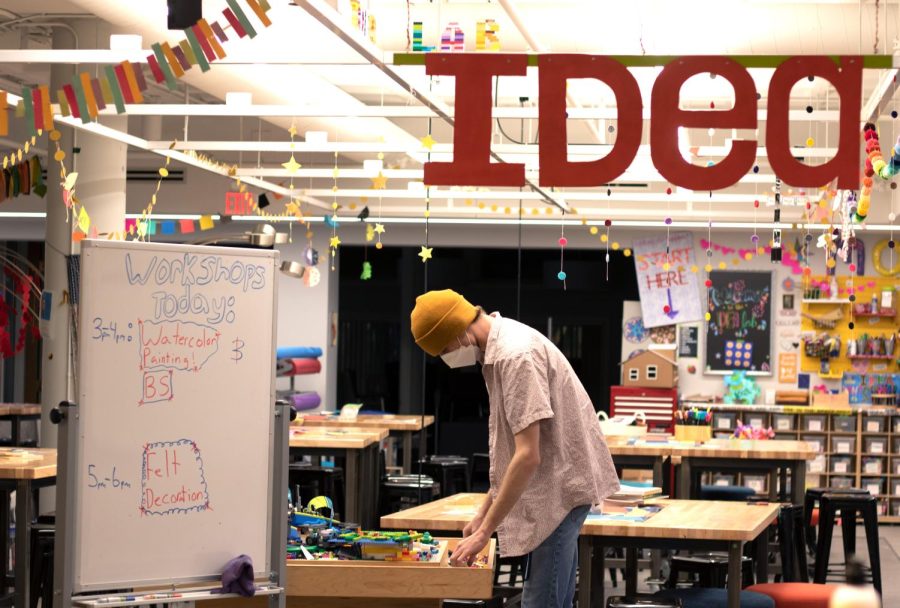The Idea Lab does not belong in the library
March 3, 2022
It is a sad fact that our library lacks a scholarly appearance. It does not have the architectural grandiosity of many other university libraries, or even its next door neighbor, Old Main. This is a shame because architectural grandeur adds to one’s intellectual life. That said, there is not much to do about the outward appearance of our library. What diminishes the scholarliness of our library the most is the Idea Lab, located on the second floor.
Although the Idea Lab is a popular space among students now, it caused quite a bit of backlash when it was first introduced in 2017. Some students were concerned that the Idea lab would pose as a capitalistic intrusion into a community space (this was raised mostly because the Idea Lab operates under the Entrepreneurship Office). Others were dissatisfied with the extra-academic appearance of the space in what they took to be the core of academic life. Similar points to the argument I will make have already been made a few years ago, but I do think some of those points are worth going back to.
It is obvious that the Idea Lab is not the most conventional of academic spaces. When I think of an academic library, I primarily think of books, journals and similar sources of intellectual value. This is not to say that the Idea Lab serves no academic purpose. In 2018, Paul Cantrell from MSCS defended the Idea Lab against this argument, gracefully listing a whole lot of academic work that was done in, or supplemented by, the Idea Lab. He is absolutely correct: the resources of the Idea Lab can enrich academic study, and a lot of professors have already integrated them into their classes.
I also want to acknowledge that the Idea Lab probably helps a lot of students learn. It is a space dedicated to creativity, and I am inclined to believe that the space has a lot of pedagogical importance. The arts-and-crafts method of learning is not my personal preference, but I will not argue that the Idea Lab should not exist, rather that its place is not the library.
The library should be a place where people sit and write papers without getting up to mend some jeans. It is important that we make distinctions in organizing our campus, giving each building and each space a clear and distinct purpose. There is, after all, a logic behind this: we want members of the college community to be able to orient themselves efficiently and effectively. Olin-Rice, for example, is where one studies the natural sciences. If you go to Old Main, you will encounter the humanities. The library has a unifying function for all the disciplines: no matter what field you undertake your studies in, the library is the place to devote yourself to serious intellectual pursuits. As such, the library should be able to cultivate a space dedicated for serious academic inquiry.
Given this purpose, the presence of the Idea Lab on the second floor of the library does a disservice to the building and our community. The second floor of the library is hardly a place for serious intellectual pursuits, but a place to play with legos and repair jeans. Let’s face it: whatever the intention was behind putting the Idea Lab there, it was a mistake. Our library sacrificed some of its collegiate gravitas for the sake of a distracting, puerile arts-and-crafts station.
Some readers may accuse me of having a regressive, traditionalist attitude towards education and what academia should be like. That is entirely correct: most of what bothers me about the Idea Lab is that it digresses from a more traditionally scholarly environment. I am not opposed to the Idea Lab altogether. My only claim is that the library should remain a traditionally intellectual institution where people go to read and write. There are other buildings on campus that are more suitable to host such a space. With all its dedication for the arts and creativity, JWall would be a good candidate. Kagin, as a non-academic building, may make a good home for it as well. The amount of glitter and legos one may find there also suggests Ramsey Middle School as a suitable location. Our options are plentiful.
At the end of the day, it is good that the Idea Lab exists. I know people who love the space, and there are many ways our community makes use of it. I touched on the academic use of the Idea Lab a little, but, for the most part, it is a non-academic place: it is generally used as a low-stakes, relaxed creative environment where students can go and destress. If anything, our campus could benefit from more of these spaces. It just doesn’t belong in a college library.














Claire • Mar 10, 2022 at 1:08 pm
Wow. As an alumna of Mac, I’m disheartened to read such a dismissive, condescending piece. The Idea Lab sounds like a fun, different and useful place of learning, one that I may have taken advantage of had it been in existence when I was at Mac. The author fails to realize, or acknowledge, that people learn in different ways and this space promotes and supports that. The snarky lines about “The arts-and-crafts method of learning is not my personal preference” and “The amount of glitter and legos one may find there also suggests Ramsey Middle School as a suitable location” greatly detracts from whatever sensible arguments the author was otherwise making.
Katelyn • Mar 7, 2022 at 2:49 pm
While the second floor of the library may not look the most conventional, I question whether conventionality is a valuable metric. It is unclear to me how a “traditionally scholarly environment” would promote learning, or why the building’s thematic cohesion is worth taking away one of the few central spots on campus that inspire creativity. Furthermore, if one does want to study in a more traditional library setting, there are a whole 3 other floors in the library where they can do so. I, for one, would find the library a much less rich and interesting place without the idea lab.
Joel Sadofsky • Mar 4, 2022 at 4:15 pm
Is tactile learning inherently unacademic? As a library student worker, I feel that the interdisciplinary nature of the idea lab helps bring together the different segments of campus.